—by Sayani Dhara
–Reading Time – 8 min Approx
Inspired by the work of Abhishek Ganguli Learning System
Every time we hear the term ‘Dhobi’, two images come to our mind immediately. The first one is ‘dhobi pachhar’ and another one is the iconic scene from Munnabhai MBBS, that was shot in Malakshmi Dhobi Ghat Mumbai. But how many of us know that our Kolkata also has its own laundry area? Yes, like Mumbai, Delhi and Chennai, our own city also has its own laundry area named, South Dhobikhana.
 Probably it is the second oldest dhobikhana of India. It is situated in 62, Richie road, Garcha, Ballygunge, Kolkata, just beside the famous Durga Puja club – Madox Square.
Probably it is the second oldest dhobikhana of India. It is situated in 62, Richie road, Garcha, Ballygunge, Kolkata, just beside the famous Durga Puja club – Madox Square.
This is one of the oldest dhobikhanas in the country, aged almost 117 years. Inspired from the Mahalakshmi Dhobi ghat, Mumbai the British had created the city’s own open air laundry area in the year 1902. S.W. Goode, (an ICS) said in his book, “Municipal Calcutta: Its Institutions in Their Origin and Growth” that a proposal of construction of a public dhobikhana in Calcutta was taken in 1889. The land was bought accordingly at No 3, Ulfatbagan Road at Kasaibagan, later it was renamed as Woodburn Park, at a cost of Rs. 32,000. But after that no other steps were taken till 1895. At that an amount of Rs 37,000 was sanctioned for the place. Goode wrote in his book, “In 1896-97 a building equipped with 100 wash stones and an ample supply of filtered water was constructed at a cost of Rs. 23,400.”
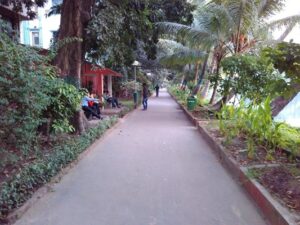 In about 1906 or 1907 the Calcutta Corporation agreed to Mr. J.C. Galstaun’s proposal to buy the land of Ulfatbagan Dhobikhana because of the beautification of this area and Mr. Galstaun also agreed to renovate the dhobikhana and to build 100 wash stones on place the Commissioners might select. This agreement was a part of the detailed settlement dealing with the old Kasaibagan burial ground. This burial ground was later converted it into Woodburn Park. According to Mr. Goode there were many delays before the new dhobikhana was constructed on the place acquired by the Corporation near the junction of Hazra and Lansdowne Road.
In about 1906 or 1907 the Calcutta Corporation agreed to Mr. J.C. Galstaun’s proposal to buy the land of Ulfatbagan Dhobikhana because of the beautification of this area and Mr. Galstaun also agreed to renovate the dhobikhana and to build 100 wash stones on place the Commissioners might select. This agreement was a part of the detailed settlement dealing with the old Kasaibagan burial ground. This burial ground was later converted it into Woodburn Park. According to Mr. Goode there were many delays before the new dhobikhana was constructed on the place acquired by the Corporation near the junction of Hazra and Lansdowne Road.
Initially, they made 180 stones on almost 24acres of land. Among that almost 167 were occupied with in 1913 to 1914. Now there are 108 concrete washing stones, divided into 9 rows and each row has 20 washing stones where dhobis wash the clothes. This dhobikhana had its other counter parts in Mumbai, Chennai and Delhi. Here the dhobis have to pay a monthly rent of Rs. 2 for each stone that they used and an another Re. 1 per month for their assistants. These stones are transferred to one generation to another.
Video by Abhishek Ganguli Learning System.
There are sheds for ironing the cloths. The term ‘istri’ came from the Portuguese language as they introduce the ironing process to the Bengali Culture. Hence, the term, ‘istri’ is denoting ironing. There are almost 400 – 500 dhobis who are working daily in this dhobikhana. There day starts at 4 – 5 am in the morning and ends at 5 in the evening.
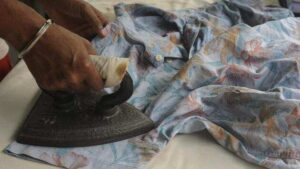
All the dirty linens of Kolkata’s hotels, restaurants, hospitals, laundries, and offices are washed in this site. First, the dirty clothes are soaked in soapy water for overnight. The whites are bleached to get cleaner and stain free clothes. Then they are washed and run through clean water. The pens are known as Hoj by the local people. They have cisterns for storing water underneath these pens.
In a day, an average of 200 linens are taken care by a single washerman. Generally, a washerman earns about Rs. 25,000 in a month. After cleaning the cloths, the cloths are put in a hydro-drier, that functions manually and helps to drain water from the wet cloths. The machine has a large steel trunk and a hand roller to operate it. The water in the dhobikhana is still supplied by Tala water tank and according to a newspaper report, the dhobikhana uses around 78,000 litres of drinkable water every day.
The South Dhobikhana is provided with low voltage electricity from the municipality and thus the use of electronic iron is restricted in this place. They use steam iron and that are operated by coal. The local body is now trying to increase water supply from Kolkata Municipal Corporation and also trying to get high voltage electricity in the near future for a better and sustainable performance.
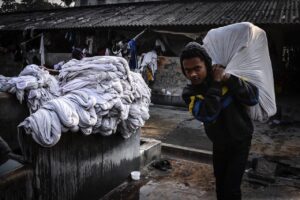
They deliver the cleaned and dried clothes by motorbikes and by even hand pulled rickshaws. Even if they provide a quality services still, they are almost half the price of the modern laundry service.
The South Dhobikhana of Kolkata, that is a Britisher’s legacy, is still maintaining it’s service quality but with simple and traditional methodologies. This site provides bread and butter to a lot of families who are involved in this business. Today, there are around 700 washermen including 235 licensed ones and 450 assistants who kept the rhythm of dhobi ghats alive in the south dhobikhana in Kolkata. A lesser-known place in heart of the city of joy, that is continuing its heritage for over a century now, should be taken a bit more care by the Government and the citizens. So that such place can maintain its glory even in the future.
—by Sayani Dhara
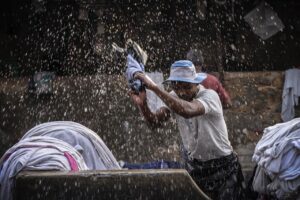

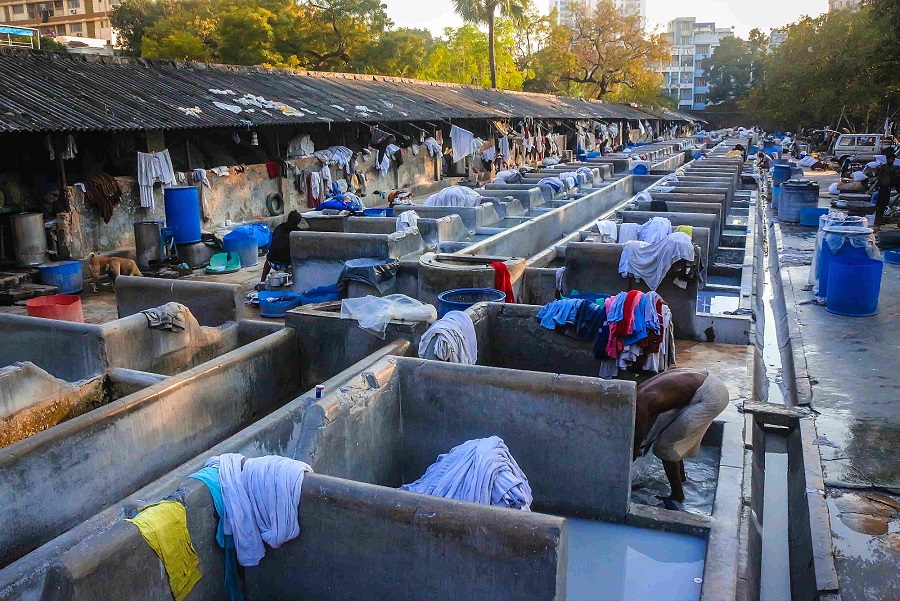
It’s a nice place to visit at least once in one’s life.
One can realise the struggle these dhobis do from early morning till late evening just to cater the clean clothes and linen.
Young generation having cell phones can click snaps as they look beyond words.